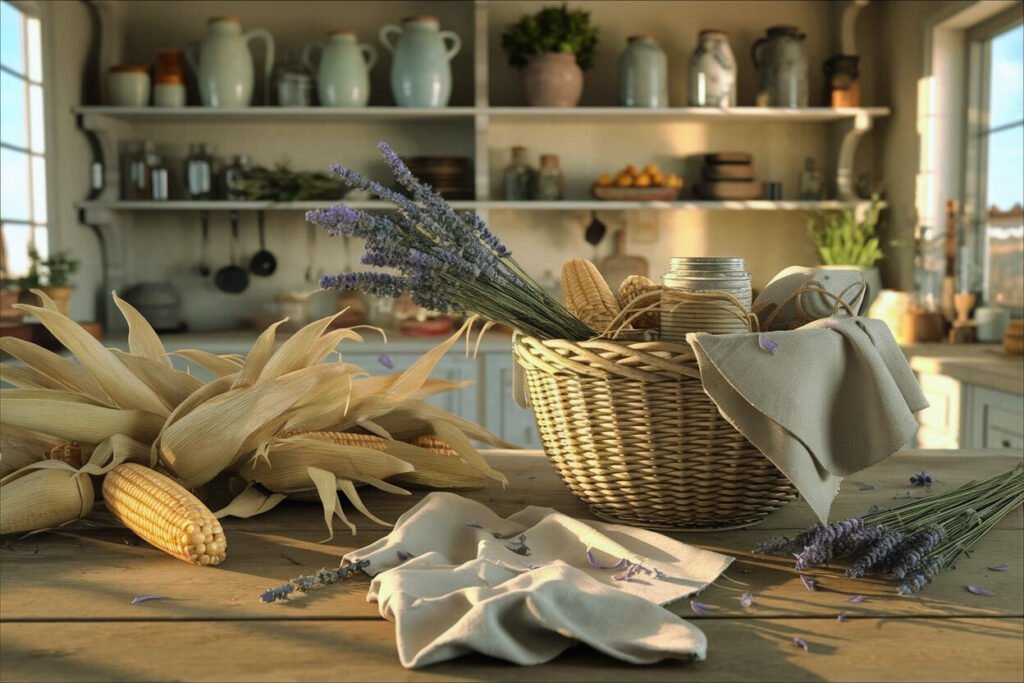
This website contains affiliate links, and some products are gifted by the brand to test. As an Amazon Associate, I earn from qualified purchases. Some of the content on this website was researched and created with the assistance of AI technology.
Key Takeaways
- Keep it low, linear, and built on solid mechanics: short wired lavender bundles for line and scent, corn husks for texture and volume.
- Protect surfaces and simplify resets: line the table, weight the base, and assemble the garland in modular sections you can lift in one move.
- Standardize finishes—one ribbon, one metal tone, a disciplined palette—so every vignette (table, sideboard, console) feels related, not repetitive.
Creating a Lavender and Corn Husk Table Garland starts with a simple promise: calm, herbal fragrance meeting rustic texture that looks intentional from every chair. I’ve built this garland on cramped condo tables and broad farmhouse planks, and the rule never changes—function first, beauty threaded through it. Lavender supplies motion and scent; corn husks deliver shape, warmth, and that harvest hush that makes a room slow down.
This piece reads generous without stealing elbow room. I keep the profile low, the construction sturdy, and the components food-adjacent, not food-touching. Short, wired lavender micro-bundles sit at 45 degrees for a flowing line. Corn husks—softened and trimmed—fan like quiet wings. Done right, guests lean in, breathe, and never brush a sleeve against a stem.
| Preparation | Layering | Furniture Placement | Lighting & Finishing Touches |
|---|---|---|---|
| Choosing lavender, husks, and natural add-ins | Building structure with twine, herbs, and texture | Placing garlands across tables, sideboards, and windows | Balancing candlelight, scent, and photography angles |
| Cleaning, trimming, and prepping natural elements | Color blending with berries, wheat, and soft gold tones | Creating reflections using glass, metal, and natural light | Layering warm tones and candlelight for Thanksgiving mood |
| Design planning for consistent farmhouse styling | Integrating herbs and spices for aroma depth | Connecting decor across furniture for cohesive flow | Adding personalized guest touches and scent continuity |
| Organizing workspace and natural material storage | Experimenting with height and texture contrast | Styling around buffets, hutches, and reflective windows | Photographing final setup with natural and candle light |
- Choose lavender, corn husks, and rustic botanicals.
- Clean and trim dried stems for easy assembly.
- Pre-plan placement across tables and windows.
- Lay out twine, scissors, and accent materials.
- Build base garland structure with twine and husks.
- Add lavender, herbs, and textural wheat layers.
- Blend soft gold and neutral tones for balance.
- Integrate scent elements for multi-sensory depth.
- Arrange garlands across sideboards and hutches.
- Highlight windows and reflective surfaces.
- Balance height across furniture for unity.
- Ensure functional space for dining and decor flow.
- Layer candlelight and soft accent lighting.
- Keep scents subtle and complementary.
- Add personalized touches for each guest.
- Capture photography in golden-hour warmth.
How to Prepare Lavender and Corn Husks for Thanksgiving Garland Making
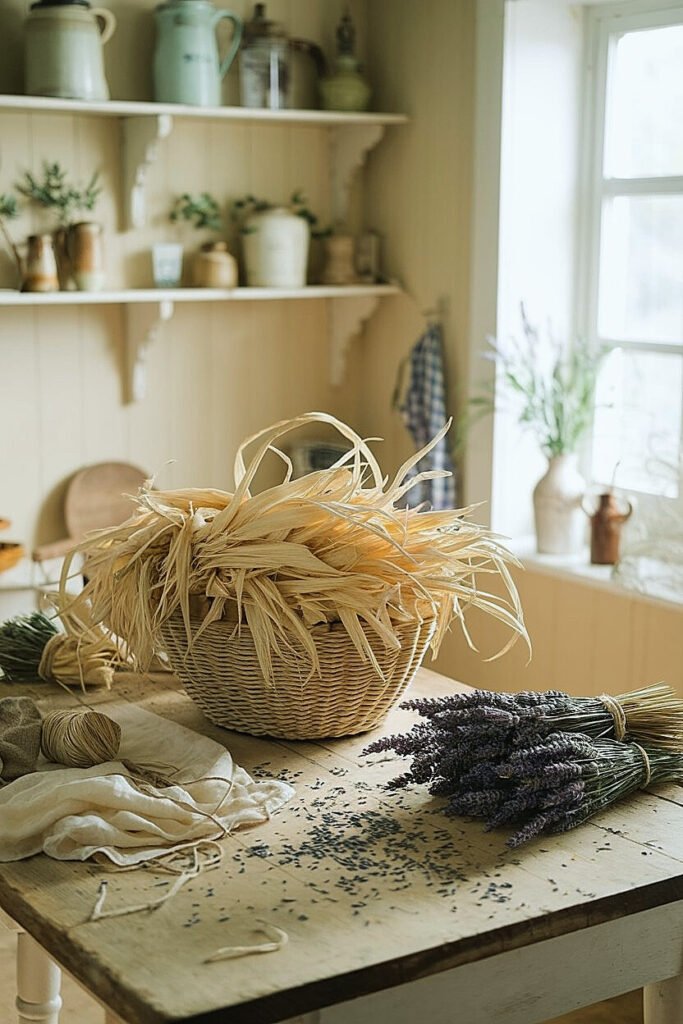
Prep isn’t glamorous, but it decides the finish. I dry English lavender (Lavandula angustifolia) flat in a cool room so the buds stay tight and the color holds dusky blue-violet. I group stems by length: 4–5 inches for front edge finesse; 6–8 inches for the spine. Each micro-bundle gets floral wire and a tiny floral tape wrap to control shed. Keep everything pointed one direction—you’re composing cursive, not block letters.
Corn husks come next. I soak food-grade husks in warm water for 10–15 minutes to soften, then pat dry until just pliable. I trim stringy ends, cut some into narrow ribbons, and keep a few broader pieces to act as “fans.” A quick press with a warm iron flattens curls if I need a cleaner look. Store prepped husks under a barely damp towel so they don’t snap while you assemble.
Sort lavender by length and wire into small, taped bundles; soak and trim husks to a pliable, clean edge; keep all stems oriented in one flow direction for easy assembly. For color pairing ideas that harmonize with herbal textures and berry tones, see Mixing Lavender and Cranberries in Thanksgiving Decor and share this guide with a friend who loves a calm, fragrant holiday table. There’s more technique ahead—keep reading for base materials that make the garland behave.
What Are the Best Materials to Use for a Thanksgiving Corn Husk Garland Base
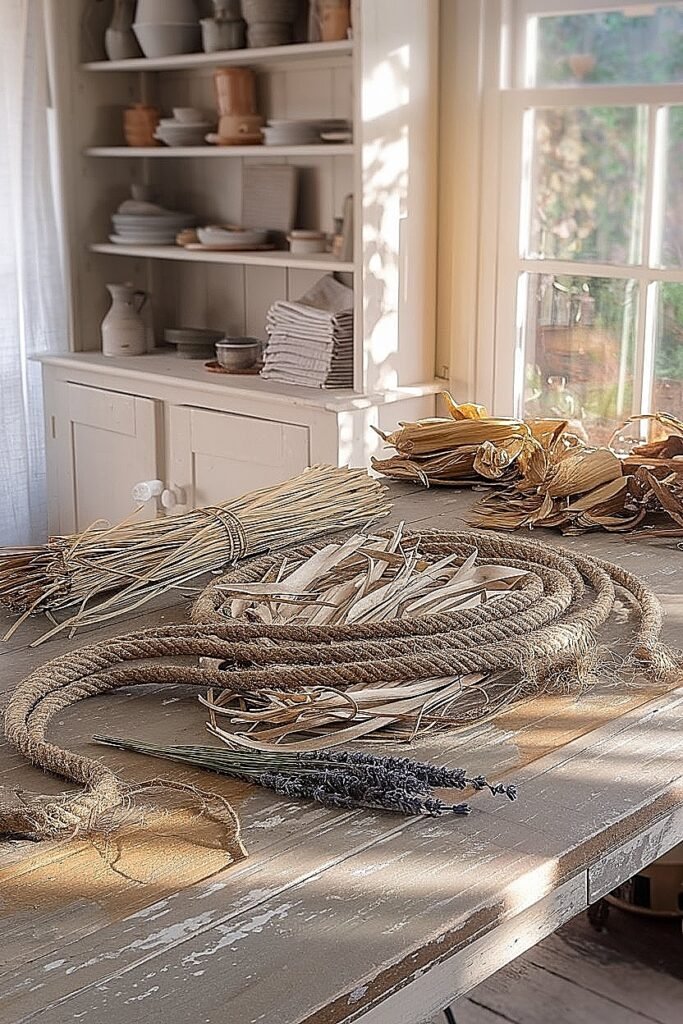
- Jute Twine Rope (3/8-inch):
I use jute when I want a flexible spine that hugs a farmhouse table edge. It’s grippy, holds knots, and takes floral wire without sliding. I measure the table length plus 12 inches, then pre-tie anchor loops at both ends. Jute’s subtle texture disappears under husks and lavender yet provides just enough heft to keep the line straight. If the table is slick, I dot a few felt pads underneath. Bonus: jute coils neatly for storage without memory kinks. - Green Paddle Wire (22–24 gauge) + Chicken Wire Ribbon:
For more structural builds, I create a narrow “ribbon” of chicken wire (2–3 inches wide) and bind the edges with paddle wire every 8 inches. This gives me a low platform that holds shape across table gaps and resists sag when you add heavier accents (wheat, mini artichokes). It’s still slim, so it doesn’t steal place-setting space, and it hides easily beneath husk fans and greens. - Eucalyptus/Olive Foliage Runner:
When you want speed and fragrance, a pre-made olive or seeded eucalyptus runner acts as a living base. I secure it with discreet zip ties to the table anchors and stitch lavender and husks directly into the stems. The foliage softens edges, covers mechanics, and adds tonal greens that flatter lavender’s bloom and husk straw. Keep a mister handy to revive leaves before guests arrive.
Choose jute for flexibility, chicken wire ribbon for structure, or a foliage runner for speed and scent; all three play nicely with wired lavender bundles and husk fans. More assembly mechanics are next—keep reading to build a garland that survives a bustling feast.
How to Assemble the Thanksgiving Garland for a Farmhouse Table
Assembly starts with protection and weight. I lay a narrow silicone runner or kraft paper strip down the table’s center to shield the wood, then set my base (jute, chicken wire ribbon, or foliage runner). I anchor the ends with low-profile command hooks under the table edge or tie to end handles if it’s a trestle. If guests will reach across, I keep total height under five inches and depth under six.
I work back to front. First pass: corn husk fans every 8–10 inches, alternating left-right for a scalloped rhythm. Second pass: wire in lavender bundles at 45 degrees, all pointing the same direction, nestling stems under husk seams so mechanics vanish. Third pass: fill with olive/eucalyptus to hide wire, then spot-check for loose bits. If I need volume at the center, I add a single hydrangea wedge at the back like a soft pillow—never at the front edge where sleeves travel.
Protect the surface, anchor the base, lay husk fans for volume, then stitch in short lavender bundles on consistent angles; finish with foliage to hide the hardware and cap the height. More styling ahead—keep reading to weave this garland into the table without crowding plates.
Ways to Integrate a Thanksgiving Garland with Table Décor
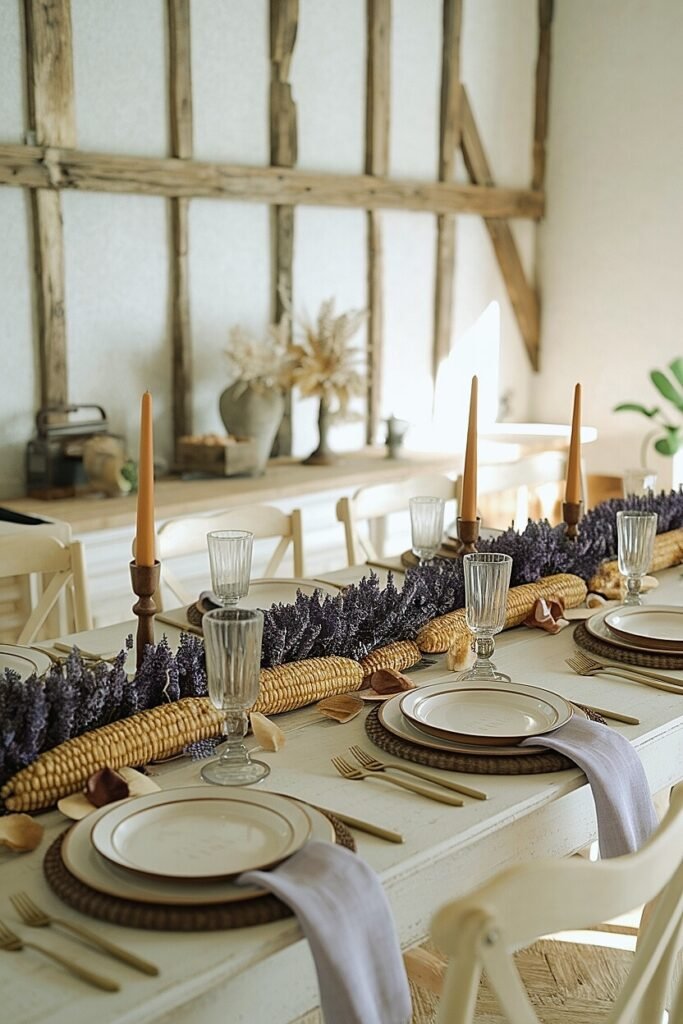
- Plate Lane Preservation:
I map two “platter lanes” on either side of the garland by keeping the depth to six inches max. I use low oval platters and position serving spoons handle-out to prevent cross-traffic. The garland reads generous but never steals elbow room. - Candle Discipline:
I use unscented, low-profile candles—frosted votives or short pillars in hurricanes—spaced every 18–24 inches. I avoid wax near husks; I seat candles on pewter or stone coasters with a 1-inch safe border. Lavender carries the scent; candles carry the glow. - Napkin Echo:
I thread a single 3-stem lavender sprig into each napkin ring and match the ribbon to the garland tie—one color only (bone linen or eggplant velvet). The repetition looks intentional and photographs beautifully. - Place Cards with Herb Clips:
I clip bone-card place names to mini herb sprigs (rosemary or thyme) and set them just outside the garland’s edge. Guests find seats quickly without nudging foliage. - Metallic Restraint:
I pick one warm metal (copper or brass) and one cool (pewter). I scatter two or three small pieces—salt cellars, butter knives—so the table sparkles without turning shiny. - Elevated Water Strategy:
I place carafes at the table ends, not mid-run. Nothing stalls a meal faster than reaching through a garland for water. Ends keep the rhythm clean. - Modular Center:
If a turkey platter needs the center, I build the garland in three sections with hidden magnetic joins. The middle pops out in one lift, then tucks back after service.
Guard platter lanes, keep light low and unscented, repeat one ribbon and two metals, and build modular sections for service flexibility. There’s more room shaping ahead—keep reading for sideboard moves that echo your centerpiece without copying it.
What Are the Best Sideboard Styling Ideas for Thanksgiving Lavender and Corn Husk Garlands
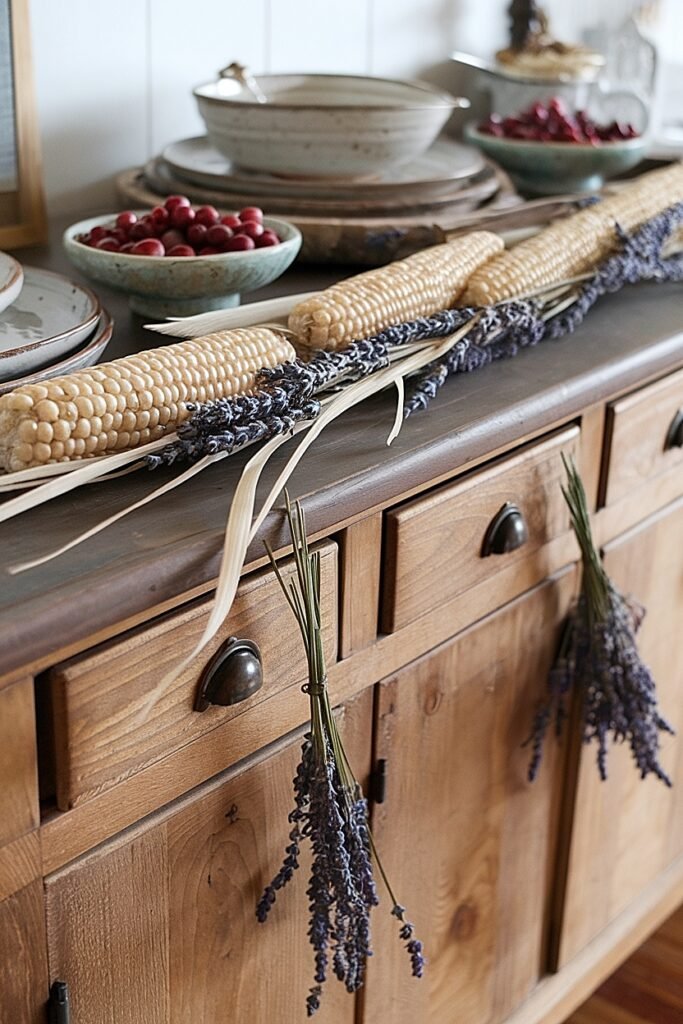
- Tray-Grounded Runner:
I coil a slim garland on a reclaimed wood tray with LED jars nested inside. The tray corrals edges and lifts off in one move when pies arrive. - Mirror Echo:
Under a wall mirror, I run a low husk-lavender strip and add mercury votives in front. The reflection doubles glow and color without extra height. - Lantern Bridge:
I flank the sideboard with matched lanterns and bridge them with a short garland section. It frames the surface while leaving platters room to land. - Basket Collar:
I wrap a lavender-husk collar around a handled wicker basket that holds napkins or favors. It’s mobile, practical, and stitches the look across the room. - Cloche Moment:
I seat a tiny white pumpkin under a glass cloche and ring the base with a mini husk-lavender wreath. Protected focal, zero sleeve risk.
Use trays, mirrors, lanterns, and baskets to keep the sideboard flexible and consistent with your table story. There’s more color craft ahead—keep reading to blend accents that flatter straw and bloom.
How to Blend Color Accents Within Lavender-Corn Husk Garland Designs
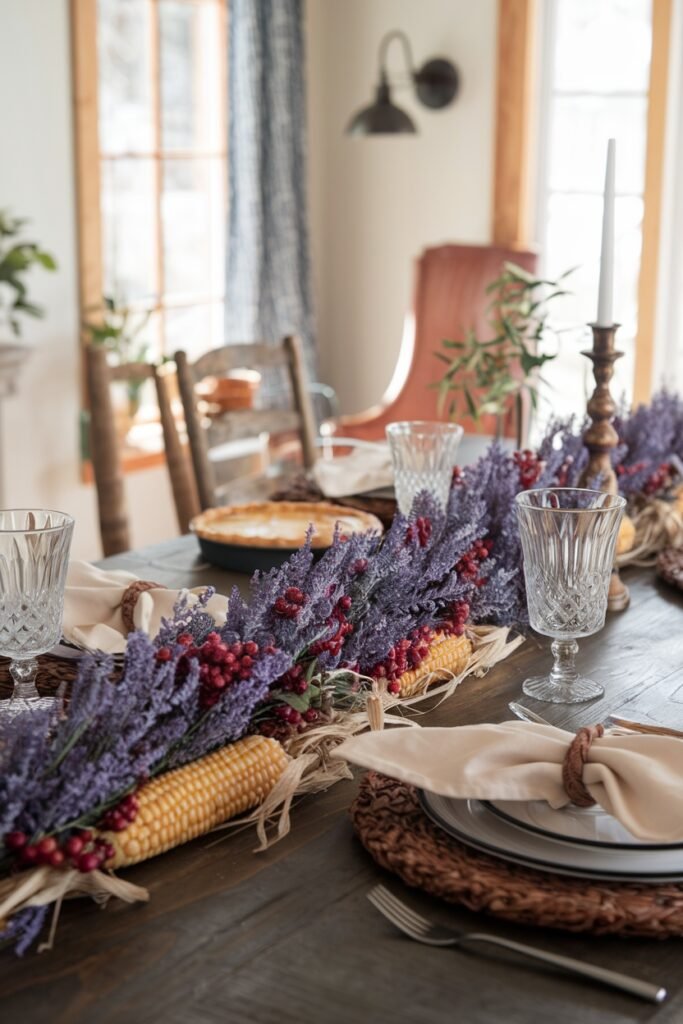
Color control makes this duo sing. Corn husks bring warm straw; lavender brings cool bloom. I bridge them with a restrained palette: bone linen, sage or olive greens, and one metal tone (copper for warmth or pewter for calm). If the room skews dark, I introduce dusty blue stoneware to cool the straw. If it’s bright, I tap walnut wood or leather to ground the lavender.
Tiny doses of berry red or fig plum can punctuate, but I treat them like exclamation points. A single pewter saucer of cranberries on the sideboard, or a fig slice on a cheese board—never in the garland where juice could stain. Lighting matters: frosted glass softens lavender’s coolness; mercury cups bounce the hue and double the effect. Angle glow toward the garland spine to deepen shadows and add dimension.
Pair straw and bloom with bone, olive, and one metal; add micro hits of berry or plum outside the garland for saturation; let soft, angled light knit it together. More materials next—keep reading for add-ins that amplify texture without crowding plates.
What Are the Best Add-Ins to Combine with Lavender and Corn Husk Thanksgiving Garlands
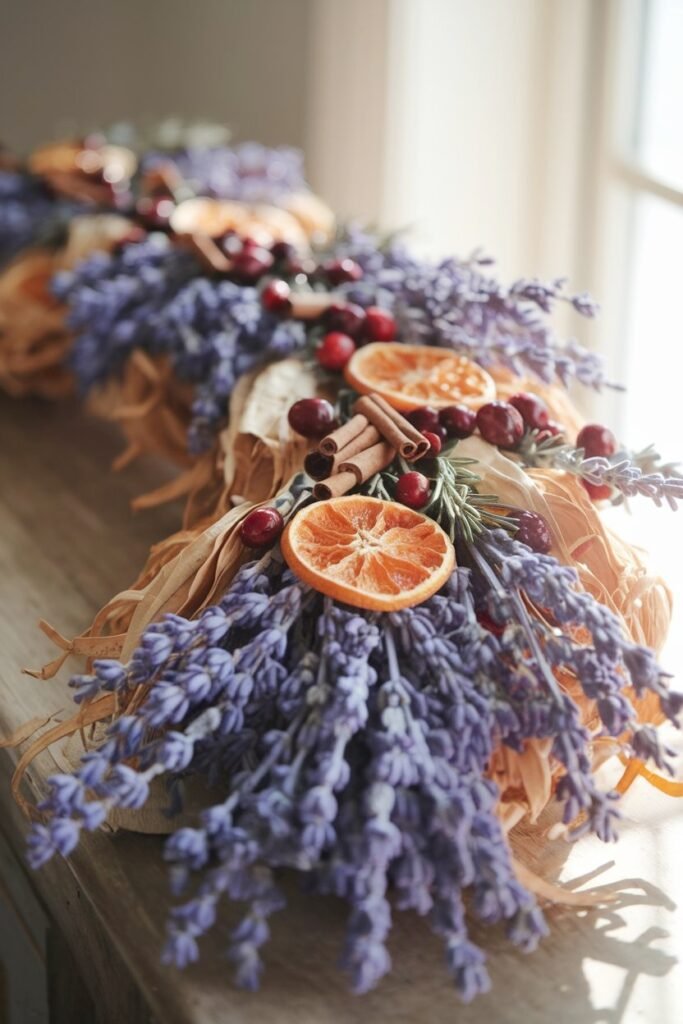
- Olive or Seeded Eucalyptus:
These greens soften mechanics, add herbal depth, and extend lifespan. I weave short sprigs along the spine and let a few tips peek over husk edges. The round seed pods catch light and echo lavender buds without competing. - Wheat Sheaves (8–10 inches):
Wheat adds structure and autumn warmth. I tuck small fans at 12–16 inch intervals on the back edge only, so sleeves glide over the front. Wheat’s linear grain pairs with lavender’s arc for movement without height. - Dried Hydrangea Wedges:
One or two heads, trimmed tight, offer mass where the table feels sparse. I seat them in back corners like soft anchors, then arc lavender between them. Go muted—ivory, blush, or antique green to avoid color fights. - Juniper with Blue Berries:
A few clipped tufts tie into lavender’s cool spectrum and whisper winter. I use them sparingly near the center to avoid resin near plates, and I keep needles trimmed to prevent poke. - Dusty Miller Pads:
I feather small pads where wires meet husks to hide seams and mirror lavender’s silver cast. It’s a subtle trick that makes the build look seamless in photos and in person.
Combine one structural stem (wheat), one mass (hydrangea), and two cool foils (juniper, dusty miller) with a green base (olive/eucalyptus) to let lavender lead while husks warm the scene. One last evolution ahead—keep reading to carry this piece into winter without rebuilding from scratch.
How to Transition a Lavender and Corn Husk Garland from Thanksgiving to Winter Decor
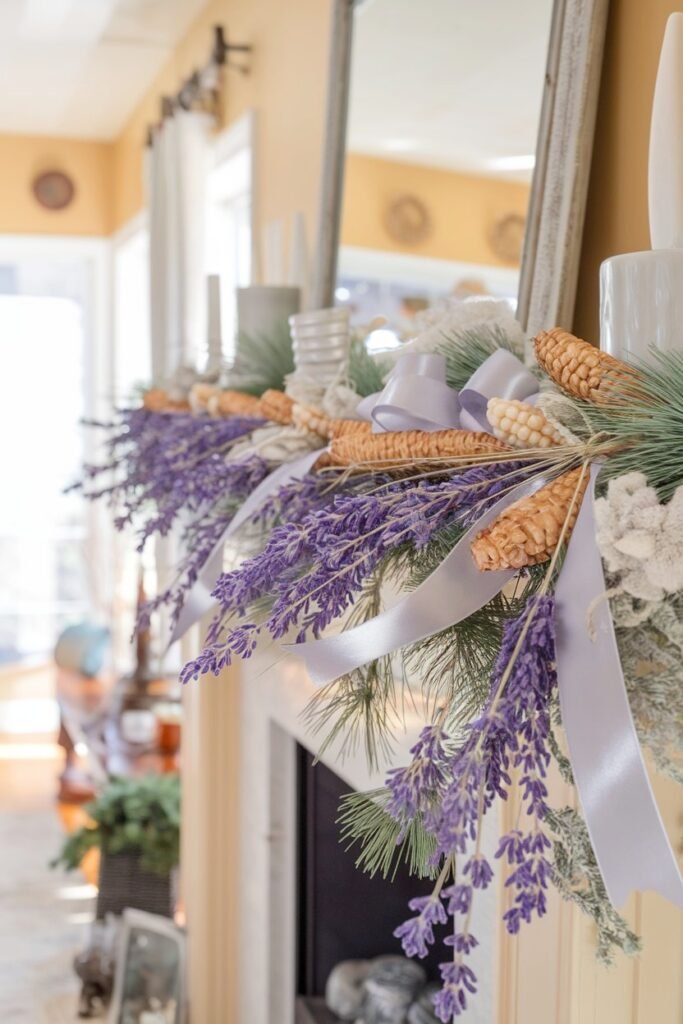
I never toss a good base. After Thanksgiving, I remove any fruit or food-adjacent accents, then tighten the profile. I swap wheat for cedar or fir tips, keeping cuts short so the garland stays low. I add a narrow velvet ribbon in charcoal or forest green and introduce a few pinecones for weight. Lavender remains, but I reduce visible bundles so scent becomes a whisper under evergreen.
Lighting shifts too. I trade frosted votives for warm white LEDs in small jars or fairy lights threaded under the husk edges. Mercury glass steps forward and brass steps back, unless your room needs warmth—then copper stays. On the sideboard, I move the garland into a tray, add a cloche over a simple ornament, and call it done. The room reads winter, not leftover harvest.
Strip perishables, swap wheat for evergreen, quiet the lavender volume, and shift metals and light toward winter warmth; keep the base intact to save time and preserve flow. There’s more craft threaded through this piece—keep reading back through the sections to fine-tune it to your room’s light, table size, and guest traffic.
Conclusion
A lavender and corn husk garland earns its place when it behaves beautifully under pressure. Build on a dependable base, wire short lavender bundles for a clean line, and fan softened husks for texture that flatters without crowding. Protect the table, keep flames low and unscented, and repeat one ribbon and one metal across the room. Anchor sideboards with mobile trays, edit hard before guests arrive, and plan the winter swap so the look rolls forward with minimal lift. Do that, and your table will feel composed, fragrant, and unmistakably yours—calm herbal line, harvest warmth, and a profile that lets conversation breathe.
This website contains affiliate links, and some products are gifted by the brand to test. As an Amazon Associate, I earn from qualified purchases. Some of the content on this website was researched and created with the assistance of AI technology.
